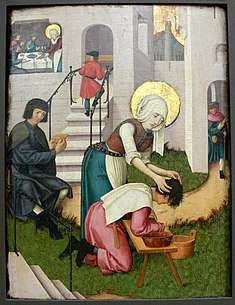Verena
Saint Verena is an early Christian saint and hermit associated with the Theban Legion.
Saint Verena | |
|---|---|
 18th-century depiction in Bad Wurzach parish church | |
| Born | 3rd century |
| Died | 4th century Bad Zurzach, Switzerland |
| Venerated in | Roman Catholic Church Eastern Orthodox Churches |
| Major shrine | Bad Zurzach, Verena Gorge Hermitage |
| Feast |
|
| Attributes | comb; water jar |
| Patronage | poor; sick; lepers; young girls, nurses |
She is especially venerated in Switzerland, where her cult is attested in Bad Zurzach, the reported place of her burial, from at least the 5th century. She is recognized as a saint in the Roman Catholic Church as well as in the Eastern Orthodox Church and the Oriental Orthodox Churches.
Legend
The oldest tradition of the life of Verena is found in the so-called Vita prior by Hatto, the abbot of Reichenau (and later bishop of Mainz), written in c. 888. The younger Vita posterior was most likely written by a monk in Zurzach in the 11th century, the oldest extant copy dating to the 12th century.
According to Hatto's account, Verena was born in Thebes as the daughter of a notable Christian family. She was educated by a bishop named Chaeremon (Vita prior, ch. 3). A bishop Chaeremon of Nilopolis is mentioned by Eusebius as martyred in 250, which would place Verena's birth before that date. The year of her death was calculated as 344 by Johannes Laurentius Huber (1812–1879), provost at Verenamünster in Zurzach, which would imply she was more than 95 years old at the time of her death.
After the death of Chaeremon, Verena travelled to Lower Egypt with a group of Christians, where the Theban Legion was being recruited. With the Theban Legion, she then travelled to Milan (Vita prior ch. 4).
While still in Milan, she heard of the martyrdom of the Theban Legion (an event of uncertain historicity, traditionally dated to 286, during the reign of Maximian) and travelled to Agaunum (Saint-Maurice). In later sources, she is said to have buried the martyred legionnaires.
She then moved on to Salodurum (Solothurn) and joined a hermitage, and spent her days in fasting and prayer, and working miracles. Hatto presents her as a prototype of the consecrated virgin, telling that she attracted a following of young virgins. She was at one point imprisoned by a local governor, and Saint Maurice appeared to her in jail to console and strengthen her. After she was released from, she continued her good works. At the end of her natural days, she retired into a narrow cave.
Veneration

Her cult is attested from as early as the 5th century in Zurzach. The Verena Minster in Zurzach was built over the grave of Saint Verena in a Roman cemetery.[1]
Her cult became widespread from the 12th century, and Verena was one of the most venerated saints in medieval Switzerland.[2] A chapel dedicated to her was present at the site of the minster of Salem Abbey in 1137. A Benedictine abbey existed in the 10th century at the site of her burial in Bad Zurzach. The former monastery was replaced by a collegiate church at some time before 1265, with Saint Verena as its patroness. The convent of beguines in Zürich, established in the mid 13th century, had a chapel dedicated to St. Verena.
Verena is often portrayed with either bread, or a jar of water in one hand, and a comb in the other, symbols of her care for the poor and lepers.[2]
The given name Verena is not recorded outside of the context of this saint; it has been associated with the name Berenice (i.e. Veronica). In reference to the saint, Verena came to be a commonly given feminine name in Switzerland, in hypocoristic form Vreni becoming an almost archetypically Swiss girls' name (c.f. diminutive Vreneli). The name Verena or Vreneli was also transferred to numerous female figures in Swiss folklore and mythology; notable among these is the Vrenelisgärtli ("Verena's garden") glacier of the Glärnisch massif.[3]
Verena Gorge Hermitage north of Solothurn, ostensibly the site of Verena's hermitage, is known to have been in existence since the 12th century (the older of the two chapels has foundations of the 12th century). The presence of a resident hermit is recorded for 1442. The site features stations of the cross dating from 1613 (restored around 1990). In the 18th century, the gorge was developed as a landscape garden in the style of Romanticism, notably due to the advocacy of French diplomat Louis Auguste Le Tonnelier de Breteuil. During 1810&ndash1813, the footpath along the gorge was further developed as partly Roman Catholic pilgrimage site, partly national romantic shrine for the patriciate of Solothurn. In a century-old tradition, the resident hermit is provided for by the Bürgergemeinde of the city of Solothurn.
In 1986, a delegation from Saint Verena's Church in Switzerland, brought a part of Saint Verena's relics to Egypt. The first Coptic church consecrated in the name of Saint Verena is Saint Maurice and Saint Verena’s Church in Cairo, which was consecrated by Pope Shenouda III on February 22, 1994.
In October 2004, a delegation from the Diocese of Los Angeles in the United States of America, along with Bishop Serapion of Los Angeles, Fr. Joseph Boules and Fr. Gregory Bishay traveled to Switzerland to bring a part of Saint Verena's relics to her churches in Anaheim and Orange. The Anaheim church, now located in Yorba Linda, California, [4] now has a shrine dedicated to her relic, as well as the church in Orange.[5]
References
- "Verena Minster", Switzerland Tourism
- Borrelli, Antonio. "Santa Verena di Zurzach", Santi e Beati, November 20, 2002
- Adolf Reinle, Die heilige Verena von Zurzach: Legende, Kult, Denkmäler (1948) , p. 129.
- Saint Mary & Saint Verena Coptic Orthodox Church, Yorba Linda, CA
- Saint Verena and the Three Holy Youth Coptic Orthodox Church, Orange, CA
| Wikimedia Commons has media related to Saint Verena. |